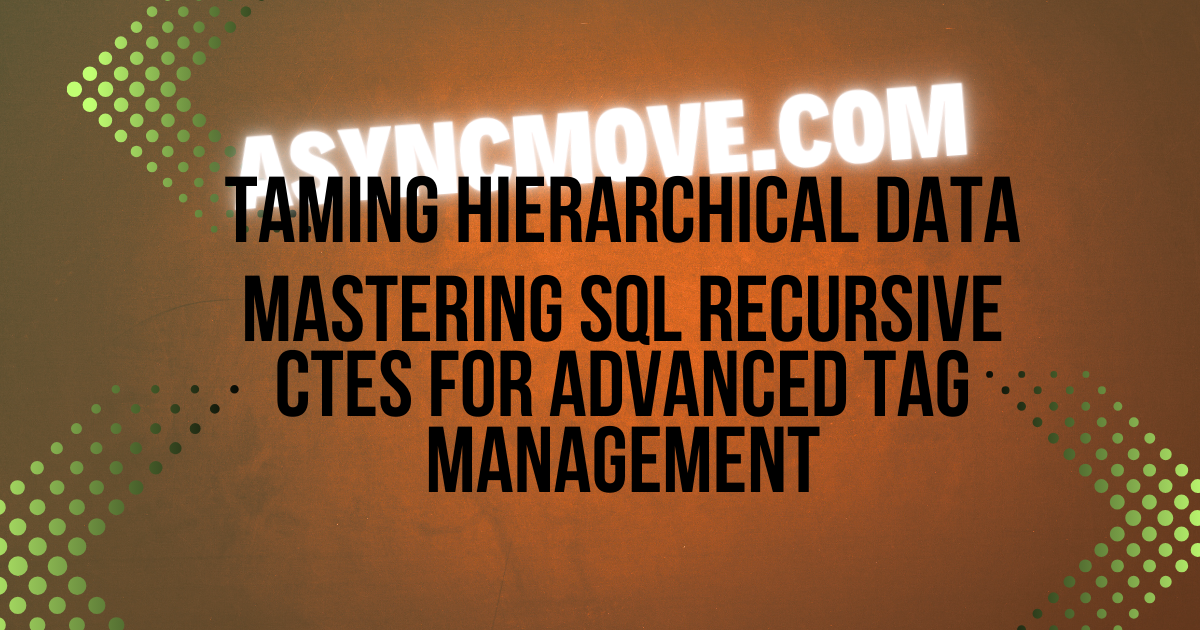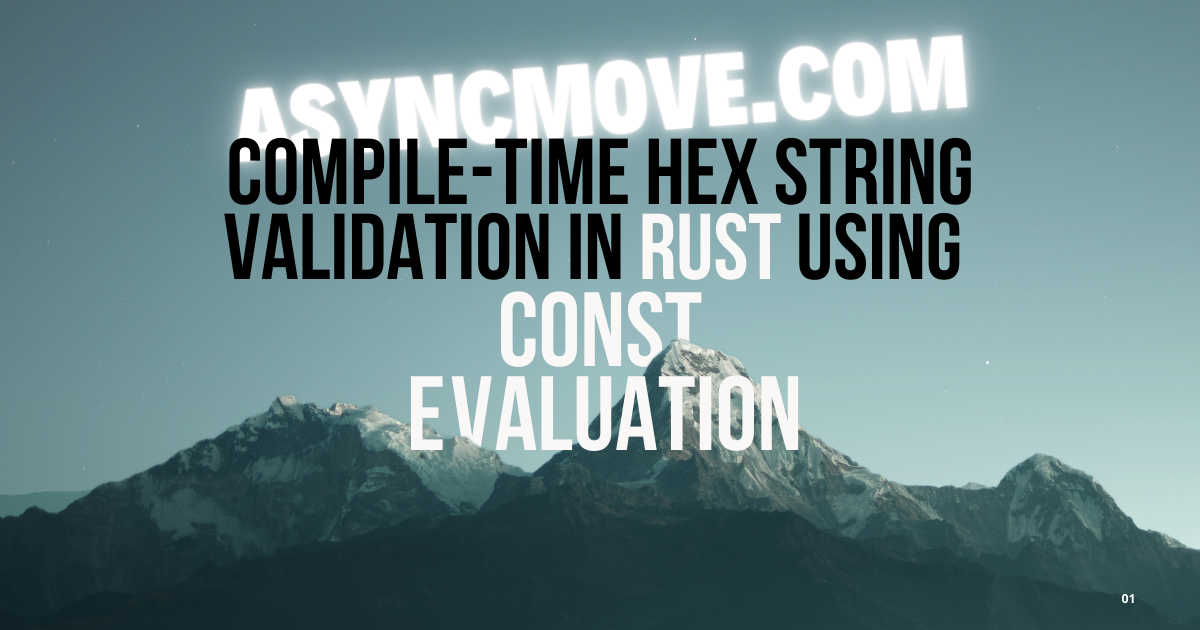Hierarchical data structures are everywhere in modern applications, from e-commerce categories to knowledge bases. This comprehensive guide demonstrates how SQL’s recursive Common Table Expressions (CTEs) elegantly solve the challenges of nested taxonomies without complex application code. Learn how to build a complete tag hierarchy system, navigate parent-child relationships efficiently, generate breadcrumb trails, prevent cyclic references, and implement powerful content filtering—all with clean, maintainable SQL queries that scale with your data’s complexity.
In modern applications, content is rarely flat. Whether you’re building an e‑commerce catalog, a knowledge base, or a technical blog, you often need to organize items into nested categories or “tags” and then query those hierarchies efficiently. Naively traversing trees in application code leads to multiple database round‑trips and brittle logic; SQL’s recursive Common Table Expressions (CTEs) offer a declarative, single‑query solution that scales elegantly with depth (stratascratch.com).
In this narrative, we’ll explore the challenges of hierarchical tagging, then walk step‑by‑step through table design and recursive queries—explaining every line of SQL—to show how self‑referencing primary keys plus CTEs solve real‑world problems.
The Challenge: Managing Nested Tags
Imagine a tech‑blog platform where articles can be tagged at multiple levels: “Technology > Databases > SQL > CTEs.” A reader landing on “Databases” expects to see every article tagged under that category and its subcategories (“SQL,” “NoSQL,” etc.). Conversely, when viewing an article tagged “CTEs,” you want a breadcrumb trail—“Technology > Databases > SQL > CTEs”—to orient the user. Finally, to safeguard your taxonomy, you must prevent cyclic parenting (e.g., “SQL” becoming a child of “CTEs,” its own descendant). Achieving all this without repetitive queries or complex application logic is the problem we face.
Introducing Recursive CTEs
SQL:1999 introduced the WITH RECURSIVE clause, allowing a query to reference itself and iteratively build result sets until completion (sqlite.org). A recursive CTE consists of two parts:
- Anchor member: the base result set (e.g., the starting tag).
- Recursive member: a query that references the CTE itself to fetch “next‑level” rows (e.g., child tags) (GeeksforGeeks).
Under the hood, the database executes the anchor, then repeatedly applies the recursive member until no new rows appear (PostgreSQL). This pattern elegantly replaces manual loops and complex joins.
Designing the Tag Schema
First, we need a table to hold tags in an adjacency‑list model:
Let’s break down each line of this schema:
CREATE TABLE IF NOT EXISTS tags- This statement creates our table only if it doesn’t already exist, preventing errors on repeated executions.id SERIAL PRIMARY KEY- Establishes a unique, auto-incrementing identifier for each tag. The SERIAL type handles the auto-increment mechanics for us.name TEXT NOT NULL- Stores the tag’s label text. The NOT NULL constraint ensures every tag must have a name.parent_id INT REFERENCES tags(id)- This is the key to our hierarchy. It creates a self-referential foreign key that points back to the same table’s id column, establishing the parent-child relationship between tags.
The INSERT statements then build our tag hierarchy:
- Root tag “Technology” has a NULL parent_id, making it a top-level tag
- Second-level tags “Programming”, “Databases”, and “Cloud Computing” reference Technology as their parent
- The tree continues with deeper nesting, like “SQL” under “Databases” and “CTEs” under “SQL”
This creates a multi-level hierarchy with paths 4 levels deep (e.g., Technology > Databases > SQL > CTEs).
Here, id is an auto‑incrementing primary key; name stores the tag label; and parent_id points back to tags.id, establishing the hierarchy (Stack Overflow). Rows with parent_id = NULL are top‑level tags.
To attach content (e.g., blog posts) to tags, we use a junction table:
Examining the content tables:
CREATE TABLE IF NOT EXISTS posts- Creates a simple content table if it doesn’t exist already.id SERIAL PRIMARY KEY- Unique identifier for each post, auto-increments for simplicity.title TEXT NOT NULL- Requires each post to have a title.content TEXT NOT NULL- Stores the actual content of the post.
The junction table is what enables many-to-many relationships:
CREATE TABLE IF NOT EXISTS post_tags- Creates our linking table.post_id INT REFERENCES posts(id)- Foreign key linking to the posts table.tag_id INT REFERENCES tags(id)- Foreign key linking to the tags table.PRIMARY KEY (post_id, tag_id)- Compound primary key ensures each post-tag combination is unique, preventing duplicate tagging.
The INSERT statements for posts create sample content, while the post_tags inserts establish the relationships. For example:
- Post 1 about “Recursive CTEs” is tagged with both “SQL” (7) and “CTEs” (9)
- Post 10 comparing SQL and NoSQL is tagged with “Databases” (3), “SQL” (7), and “NoSQL” (8)
This many‑to‑many design lets each post have multiple tags and each tag annotate multiple posts—perfect for flexible tagging (MariaDB).
Retrieving All Descendant Tags
When a user views “Databases,” we must fetch “Databases” and every nested child. The recursive CTE:
Let’s dissect this recursive CTE line by line:
WITH RECURSIVE tag_tree AS (...)- Defines a temporary result set named “tag_tree” and indicates it will use recursion.SELECT id, name FROM tags WHERE name = 'Databases'- This is the anchor (non-recursive) part of the CTE. It selects just the “Databases” tag as our starting point.UNION ALL- Combines the anchor result with what our recursive part will return. We use UNION ALL instead of UNION because we want to keep all results, and we know there won’t be duplicates based on our hierarchy.SELECT t.id, t.name FROM tags t- In the recursive part, we select the same columns but from a different source.JOIN tag_tree tt ON t.parent_id = tt.id- This is the magic of recursion. We join the tags table to our own tag_tree result set, connecting children to parents. Each iteration finds one more level of descendants.SELECT * FROM tag_tree- Finally, we retrieve all rows from our recursive CTE, giving us the full subtree.
When this query runs:
- First iteration retrieves just the “Databases” tag (ID 3)
- Second iteration finds direct children (SQL and NoSQL)
- Third iteration finds grandchildren (CTEs, Joins, MongoDB, Redis)
- Process continues until no more descendants are found
- The anchor selects the row for “Databases.”
- The recursive part joins
tagstotag_treeonparent_id = tt.id, pulling direct children, grandchildren, and so on (Stack Overflow). - The final
SELECTreturns the complete subtree in one shot.
Fetching Posts in a Subtree
To list every post tagged under “Databases” or its descendants:
Breaking down this query:
WITH RECURSIVE tag_tree AS (...)- Similar to our previous query, defines a temporary recursive result set.SELECT id FROM tags WHERE name = 'Databases'- The anchor selects just the ID of the “Databases” tag to start our tree.UNION ALL- Again combines anchor and recursive parts.SELECT t.id FROM tags t JOIN tag_tree tt ON t.parent_id = tt.id- The recursive part finds all child tags by joining the current results back to the tags table.SELECT DISTINCT p.id, p.title- Uses DISTINCT to eliminate duplicate posts that might be tagged with multiple relevant tags.FROM posts p- The main table we’re querying for results.JOIN post_tags pt ON p.id = pt.post_id- Connects posts to their tags via the junction table.JOIN tag_tree tt ON pt.tag_id = tt.id- The crucial join that filters posts to only those tagged with “Databases” or any of its descendant tags.ORDER BY p.id- Sorts results by post ID for consistency.
This query works in two phases:
- The recursive CTE builds a complete list of “Databases” and all its descendant tags (SQL, NoSQL, CTEs, Joins, MongoDB, Redis)
- The main query then finds all posts tagged with any tag in that list
Without recursion, finding all these posts would require either multiple queries or complex subqueries and unions.
Here we reuse tag_tree to filter post_tags, efficiently returning all matching posts without nested subqueries or loops (stratascratch.com).
Building Breadcrumb Trails (Ancestor Traversal)
For a post tagged “CTEs,” we want the full path up to the root:
Let’s analyze this recursive breadcrumb builder:
WITH RECURSIVE breadcrumbs AS (...)- Declares our recursive CTE named “breadcrumbs”.SELECT t.id, t.name, t.parent_id, 1 AS depth, t.name::TEXT AS trail- The anchor part selects our starting tag and initializes two special columns:depthtracks how far up the tree we’ve gone (starting at 1)trailstores the breadcrumb path, beginning with just the tag name
FROM tags t WHERE t.name = 'CTEs'- Starts with the “CTEs” tag as our anchor.UNION ALL- Combines results as before.SELECT t.id, t.name, t.parent_id, b.depth + 1, t.name || ' > ' || b.trail- In the recursive part:- We increment the depth counter
- We prepend the parent’s name to our trail string with " > " as separator
FROM tags t JOIN breadcrumbs b ON t.id = b.parent_id- This is the key difference from our descendant query. Here we join ont.id = b.parent_id(instead oft.parent_id = tt.id), which means we’re traversing up the tree rather than down.SELECT trail FROM breadcrumbs ORDER BY depth DESC LIMIT 1- Finally, we order by depth descending (to get the longest path) and limit to one row (the complete path).
This query travels upward:
- First iteration gets just “CTEs”
- Second finds its parent “SQL” and makes “SQL > CTEs”
- Third finds the grandparent “Databases” and makes “Databases > SQL > CTEs”
- Fourth finds the great-grandparent “Technology” and makes “Technology > Databases > SQL > CTEs”
- The query stops when it reaches a tag with NULL parent_id
By ordering by depth descending, we get the longest (complete) path first.
- Anchor finds the tag we want breadcrumbs for.
- Recursive joins
tagsviat.id = b.parent_id, climbing one level at a time. - We concatenate names to build strings like “Technology > Databases > SQL > CTEs” (Stack Overflow).
depth = 2 I1->>I2: Get parent (Databases) Note over I2: trail = "Databases > SQL > CTEs"
depth = 3 I2->>I3: Get parent (Technology) Note over I3: trail = "Technology > Databases > SQL > CTEs"
depth = 4 I3-->>Result: Technology has NULL parent_id, recursion stops Note over Result: ORDER BY depth DESC LIMIT 1
Returns "Technology > Databases > SQL > CTEs"
Safeguarding Against Cycles
Accidentally creating loops (A → B → A) can crash recursive queries. Before reparenting a tag, we check:
This safety check query deserves careful explanation:
WITH RECURSIVE descendants AS (...)- Defines a recursive CTE to find all descendants.SELECT id, parent_id FROM tags WHERE id = 7- The anchor starts with the tag we want to move (SQL, ID 7).UNION ALL- Combines as before.SELECT t.id, t.parent_id FROM tags t JOIN descendants d ON t.parent_id = d.id- The recursive part finds all descendants by following the parent_id references.SELECT * FROM descendants WHERE id = 9- Crucially, we filter the results to check if the proposed new parent (CTEs) is already in the descendant list.
The logic works like this:
- We get SQL (ID 7) and all its descendants (CTEs, ID 9)
- Then we check if our proposed new parent (CTEs) is in that list
- If it is (which it is in this case), making SQL a child of CTEs would create a cycle
- SQL would be a descendant of CTEs, which would be a descendant of SQL
- This cycle would cause recursive queries to loop indefinitely
In this example, the query returns one row because CTEs (ID 9) is indeed a descendant of SQL (ID 7), confirming a cycle would form if we proceeded with the update.
If this returns any rows, tag 9 is already a descendant of 7, so reparenting would form a cycle. Otherwise, it’s safe to execute:
Query Returns Rows?"] -->|Yes| Reject["Reject Change:
Would Create Cycle"] Check -->|No| Allow["Allow Change:
No Cycle Created"] style Reject fill:#f77,stroke:#333,stroke-width:2px style Allow fill:#7f7,stroke:#333,stroke-width:2px style Check fill:#77f,stroke:#333,stroke-width:2px
This simple UPDATE would make SQL a child of CTEs, but we’ve shown it would create a cycle, so we shouldn’t execute it.
Real‑Life Example: Navigating a Tech‑Blog
Let’s see how to find all posts related to the “Programming” category and all its subcategories:
Analyzing this practical example:
WITH RECURSIVE programming_tree AS (...)- Creates our recursive CTE to build the tag subtree.SELECT id FROM tags WHERE name = 'Programming'- Anchor part starts with just the “Programming” tag.UNION ALL- Combines results as usual.SELECT t.id FROM tags t JOIN programming_tree pt ON t.parent_id = pt.id- Recursive part finds all descendants of “Programming”.SELECT DISTINCT p.id, p.title- Main query selects post information, using DISTINCT to eliminate duplicates.FROM posts p JOIN post_tags pt ON p.id = pt.post_id- Connects posts to their tags.JOIN programming_tree tt ON pt.tag_id = tt.id- Filters to posts tagged with “Programming” or any of its descendants.ORDER BY p.id- Sorts by post ID.
This query would find posts under:
- “Programming” directly (though none in our example)
- “Web Development” and “Mobile Development” (direct children)
- “SQL”, “NoSQL” (grandchildren)
- “Frontend”, “Backend”, “CTEs”, “Joins”, “MongoDB”, “Redis” (great-grandchildren)
The result is a comprehensive list of all content in the “Programming” branch of our taxonomy.
Similarly, clicking into a “MongoDB”‑tagged article instantly generates an accurate breadcrumb via our upward‑CTE:
This breadcrumb query follows the same pattern as our previous breadcrumb example:
WITH RECURSIVE breadcrumbs AS (...)- Sets up the recursive CTE.SELECT t.id, t.name, t.parent_id, 1 AS depth, t.name::TEXT AS trail- Initializes with “MongoDB” tag details.FROM tags t WHERE t.name = 'MongoDB'- Sets MongoDB as our starting point.UNION ALL- Combines anchor and recursive results.SELECT t.id, t.name, t.parent_id, b.depth + 1, t.name || ' > ' || b.trail- Each iteration prepends the parent name to our breadcrumb.FROM tags t JOIN breadcrumbs b ON t.id = b.parent_id- Traverses upward to parents.SELECT trail FROM breadcrumbs ORDER BY depth DESC LIMIT 1- Returns only the complete path.
When run for MongoDB:
- First gets just “MongoDB”
- Then “NoSQL > MongoDB”
- Then “Databases > NoSQL > MongoDB”
- Finally “Technology > Databases > NoSQL > MongoDB”
This dynamically generated breadcrumb trail helps users understand where they are in your content hierarchy, enhancing navigation and context.
(Self-referencing Table)"] <--> RQ["Recursive Queries
(CTEs)"] RQ <--> CS["Content Selection
(JOIN with Junction Table)"] TH -->|"Descendant Traversal"| DT["Find All Child Tags
t.parent_id = tt.id"] TH -->|"Ancestor Traversal"| AT["Build Breadcrumbs
t.id = b.parent_id"] TH -->|"Cycle Detection"| CD["Prevent Loops
Descendants Check"] DT --> CF["Content Filtering
Show All Tagged Posts"] AT --> BC["Breadcrumb Navigation
Show Parent Path"] CD --> SI["Structural Integrity
Prevent Invalid Hierarchies"] end style TH fill:#f9f,stroke:#333,stroke-width:2px style RQ fill:#bbf,stroke:#333,stroke-width:2px style DT fill:#bfb,stroke:#333,stroke-width:2px style AT fill:#fbf,stroke:#333,stroke-width:2px style CD fill:#fbb,stroke:#333,stroke-width:2px
Conclusion
By weaving recursive CTEs into a self‑referencing schema, you transform complex tree traversals into concise, high‑performance SQL queries. This pattern powerfully addresses content filtering, breadcrumb navigation, permission inheritance, and more—without iterative application code or excessive joins. Mastering recursive tags elevates your database design, keeps logic centralized, and delivers richer, more maintainable features.






Comments